 |
|


As well as this website I also post a lot of my work on my
Facebook page. I can also be found on Twitter.

Videos are also available to view and share on YouTube. Click on
the icon above for my new YT channel.

If you wish to
connect through Linkedin, then this is the link to my
professional network.

VLC
Media Player
The best Media Player that supports all types of file formats.
Click the link to download for free.
|
|
|
Panavia Tornado
is a family of twin-engine, variable-sweep wing combat
aircraft, which was jointly developed and manufactured
by the United Kingdom, West Germany and Italy. There are
three primary variants of the Tornado; the Tornado IDS
(interdictor/strike) fighter-bomber, the suppression of
enemy air defences Tornado ECR (electronic
combat/reconnaissance) and the Tornado ADV (air defence
variant) interceptor.
The Tornado was developed and built by Panavia Aircraft
GmbH, a tri-national consortium consisting of British
Aerospace (previously British Aircraft Corporation), MBB
of West Germany, and Aeritalia of Italy. It first flew
on 14 August 1974 and was introduced into service in
1979–1980. Due to its multirole nature, it was able to
replace several different fleets of aircraft in the
adopting air forces. The Royal Saudi Air Force (RSAF)
became an export operator of the Tornado in addition to
the three original partner nations. A tri-nation
training and evaluation unit operating from RAF
Cottesmore, the Tri-National Tornado Training
Establishment, maintained a level of international
cooperation beyond the production stage.
The Tornado was used by the Royal Air Force (RAF),
Italian Air Force and Royal Saudi Air Force during the
1991 Gulf War, in which the Tornado conducted many
low-altitude penetrating strike missions. The Tornados
of various operators were used in conflicts in the
former Yugoslavia during the Bosnian War and Kosovo War,
Iraq during the Gulf War and the Iraq War, Libya during
the Libyan civil war, as well as smaller roles in
Afghanistan and Yemen. A total
of 992 aircraft were built. |
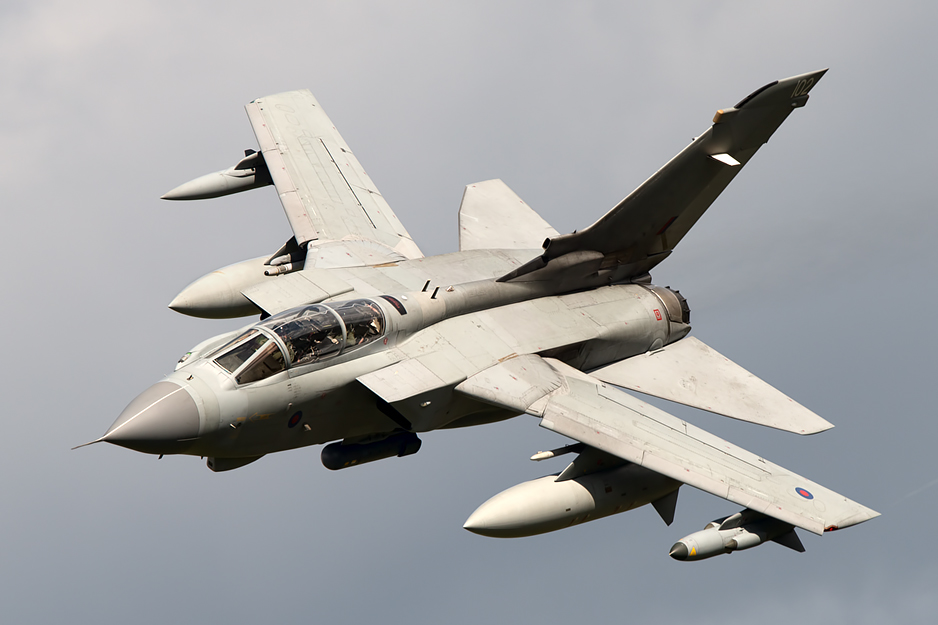 |
|
The Tornado was designed as a low-level supersonic
ground attack bomber, capable of taking off and landing
in short distances. This requires good high-speed and
low-speed flying characteristics. In general, an
aircraft which is designed to fly at high speeds usually
has poor low-speed characteristics. In order to achieve
the desired high-speed performance, an aircraft has a
highly swept or ‘delta’ wing platform. However, these
wing designs are very inefficient at low speeds where
unswept wing are required. In order for an aircraft to
be operated efficiently at both high and low speeds,
variable wing sweep is a desirable feature, this was
incorporated into the design. |
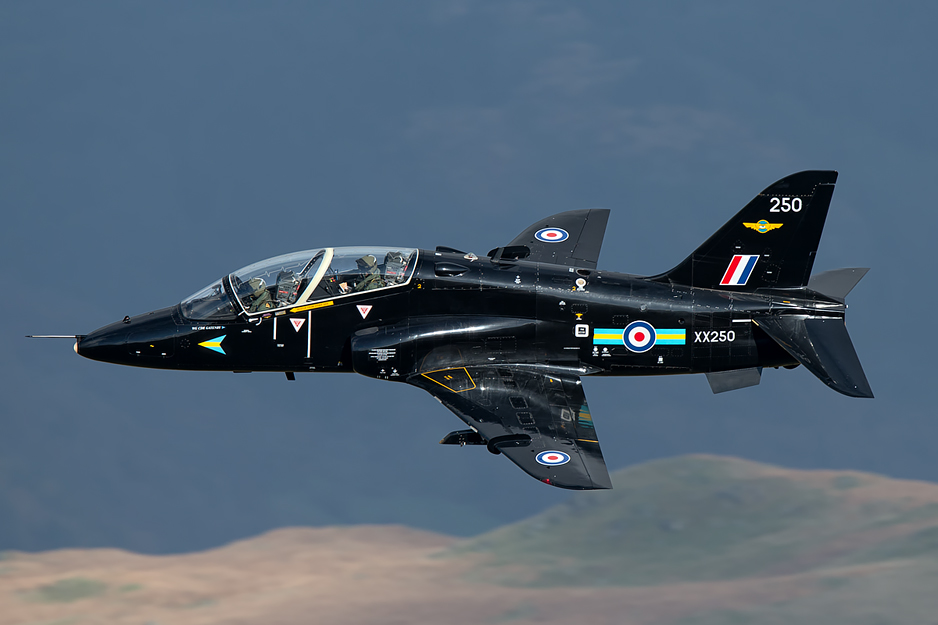 |
|
BAE Systems Hawk
is a British single engine, advanced jet trainer
aircraft. It first flew in 1974 as the Hawker Siddeley
Hawk. The Hawk is used by the Royal Air Force, and other
air forces, as either a trainer or a low-cost combat
aircraft. The Hawk is still in production with over 900
Hawks sold to 18 customers around the world.
The Hawk T1 entered RAF service in April 1976, replacing
the Gnat and Hawker Hunter in the advanced training and
weapons training roles respectively. The T1 and now been
upgraded to the new T2.
The Hawk is an all-metal, low-wing, tandem seat aircraft
of conventional design. The wing has a moderate sweep
with 2º dihedral and trailing edge slotted flaps. A
one-piece all-moving tailplane is also swept back with
10º dihedral. The fuselage comprises three main parts.
The front fuselage accommodates two equipment bays and a
pressurised cabin containing two tandem cockpits. The
centre fuselage contains the engine, a fuselage fuel
tank, a gas turbine starting system and a ram air
turbine. The rear fuselage houses the jet pipe bay and
an airbrake hinged to its under surface. The Hawk is
powered by a Rolls- Royce Turbomeca Adour 151 turbofan
engine, which is an un-reheated version of the engine
that powered the Jaguar GR3 aircraft. |
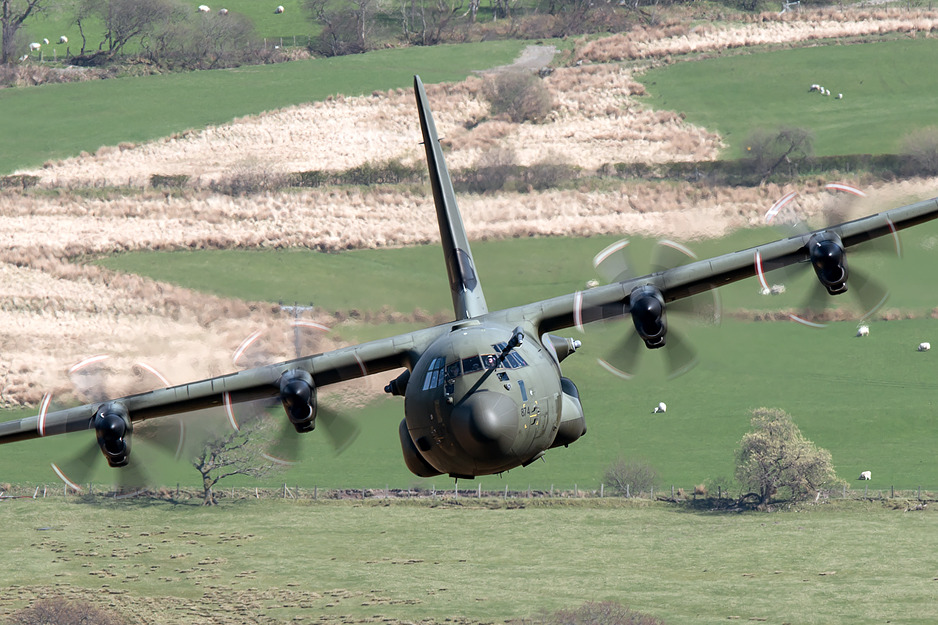 |
Lockheed C-130 Hercules
is a four-engine turboprop military transport aircraft
built by Lockheed. It is the main tactical airlifter for
many military forces worldwide. Over 40 models and
variants of the Hercules serve with more than 50
nations. In December 2006 the C-130 became the fifth
aircraft—after the English Electric Canberra, B-52
Stratofortress, Tupolev Tu-95, and KC-135 Stratotanker—to
mark 50 years of continuous use with its original
primary customer, in this case, the United States Air
Force.
Capable of takeoffs and landings from unprepared
runways, the C-130 was originally designed as a troop,
medical evacuation, and cargo transport aircraft. The
versatile airframe has found uses in a variety of other
roles, including as a gunship, for airborne assault,
search and rescue, scientific research support, weather
reconnaissance, aerial refuelling, maritime patrol and
aerial fire fighting. The Hercules family has the
longest continuous production run of any military
aircraft in history. During more than 50 years of
service the family has participated in countless
military, civilian and humanitarian aid operations. |
|
Eurofighter Typhoon
is a twin-engine canard-delta wing multirole aircraft.
It is being designed and built by a consortium of three
separate partner companies: Alenia Aeronautica, BAE
Systems, and EADS working through a holding company
Eurofighter GmbH which was formed in 1986. The project
is managed by NETMA (NATO Eurofighter and Tornado
Management Agency) which acts as the prime customer |
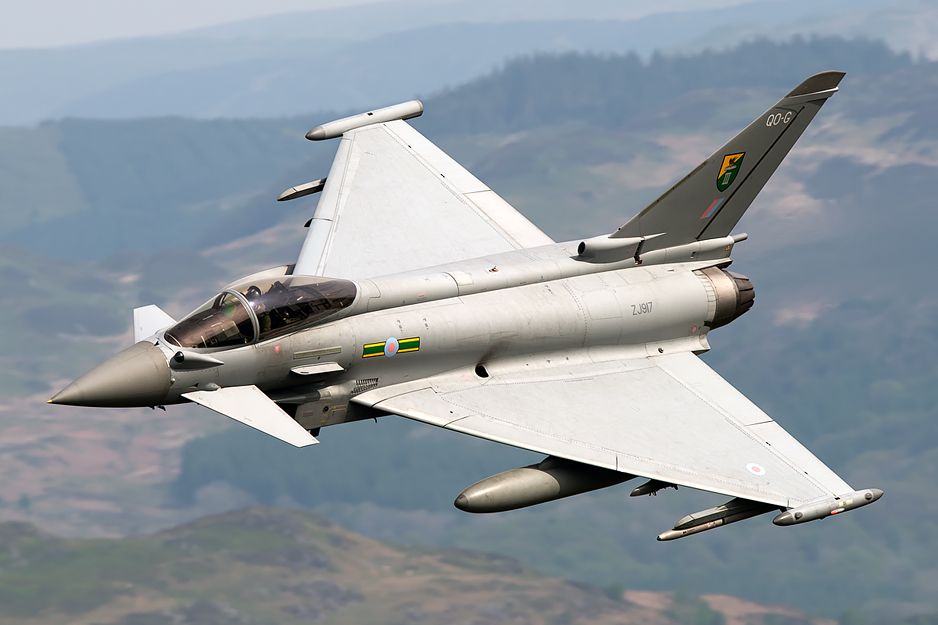 |
|
The Eurofighter Typhoon benefits from a number of
advances in technology and engineering. The aircraft
makes extensive use of composites in the airframe with
only 15% of the surface comprising metal. The newly
developed EJ200 powerplants combined with the aircraft's
aerodynamics allow it to cruise supersonically without
the use of reheat for extended periods of time even with
a normal weapons load. The advanced flight control
system and pitch unstable design impart great
manoeuvrability at high and low speeds. These, combined
with; cutting edge automated defences, advanced active
and passive sensors, leading cockpit ergonomics and a
reduced RCS instil Eurofighter with more than an even
chance of success against most competing aircraft. |
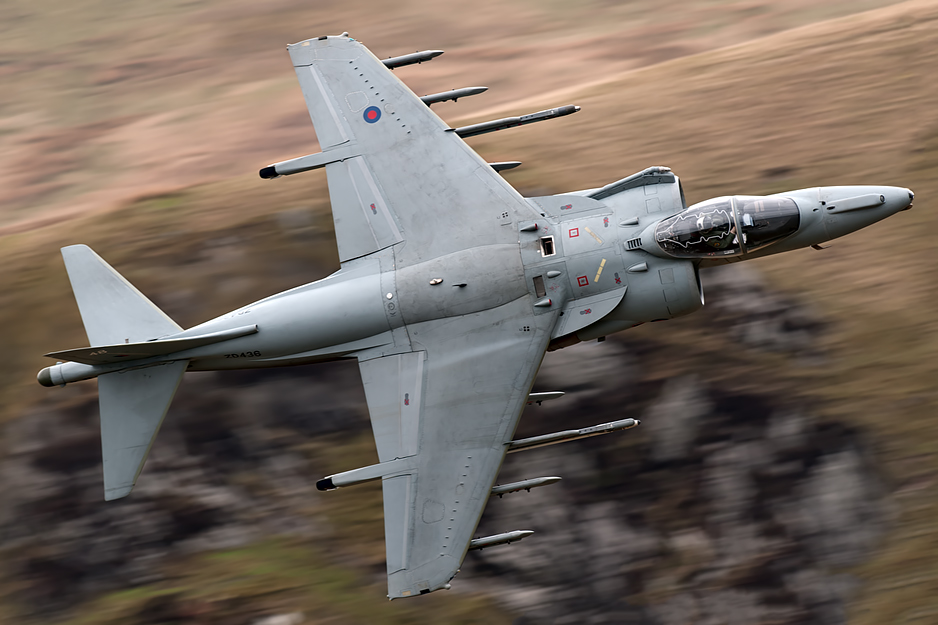 |
BAE Harrier GR9
is used by the RAF in the close air support role and is
the latest in a long line of ‘jump-jets’ dating back to
the introduction of the first Harriers in the 1960s.
Now, as part of the Joint Force Harrier, these extremely
versatile aircraft are ready to deploy anywhere in the
world, either on board Royal Navy aircraft carriers or
to shore bases. The first Harriers entered RAF service
in 1969, making the RAF the first in the world to use
its revolutionary vertical take-off and landing
abilities, which allow the aircraft to fly in and out of
areas close to the battlefield that would normally be
off-limits to other aircraft.
The aircraft are usually employed in direct support of
ground troops tackling such targets as enemy troop
positions, tanks and artillery. The Harrier uses a
variety of weapons such as Paveway Laser and Global
Positioning System-guided bombs against buildings,
Maverick infrared missiles against tanks, cluster
munitions and general purpose free-fall bombs. When
required, the Harrier can also be equipped with a pod
fitted with cameras to provide reconnaissance of the
target and battle areas. For self-defence the aircraft
can be fitted with the AIM-9L Sidewinder infrared guided
missile. |
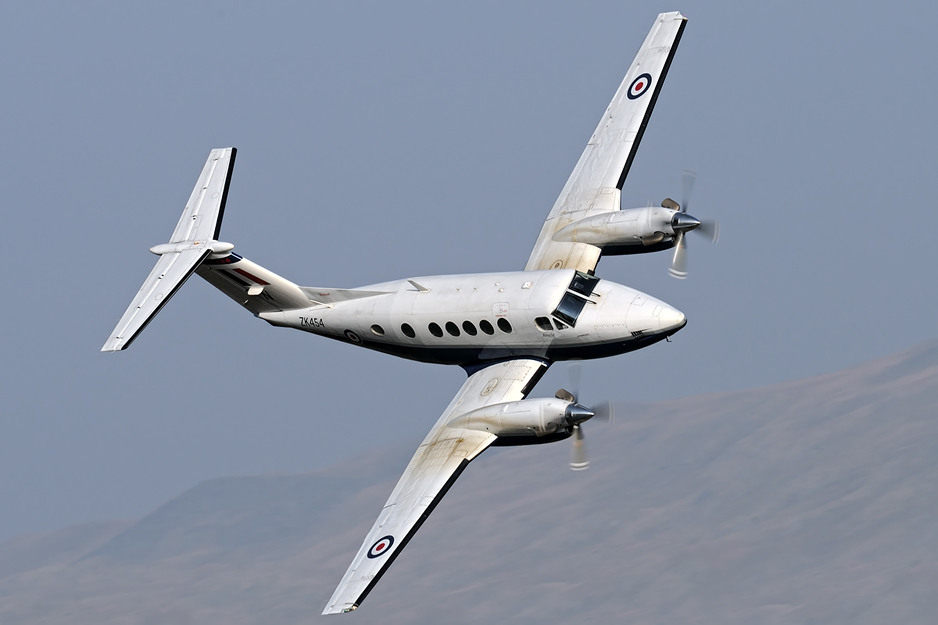 |
|
Beech King Air B200
the newest training aircraft in the RAF inventory, is a
twin-engine turboprop monoplane, which first entered RAF
service in 2004. It is used as an advanced, multi-engine
pilot trainer by No 45(R) Squadron, which is part of No
3 Flying Training School based at RAF Cranwell, in
Lincolnshire. Prior to flying the King Air, students who
have been streamed to fly multi-engine aircraft at the
end of elementary flying training undertake survival
training and personal development training to prepare
them for the rigours of operational service. |
|
F-15E Strike Eagle
is a 1980s American all-weather strike fighter. Its a
two-seat all-weather long-range strike and ground-attack
aircraft for the U.S. Air Force designed for long-range
interdiction of enemy ground targets deep behind enemy
lines. A derivative of the F-15 Eagle air superiority
fighter, the Strike Eagle proved its worth in Desert
Storm and Operation Allied Force, carrying out deep
strikes against high-value targets, combat air patrols
and providing close air support. |
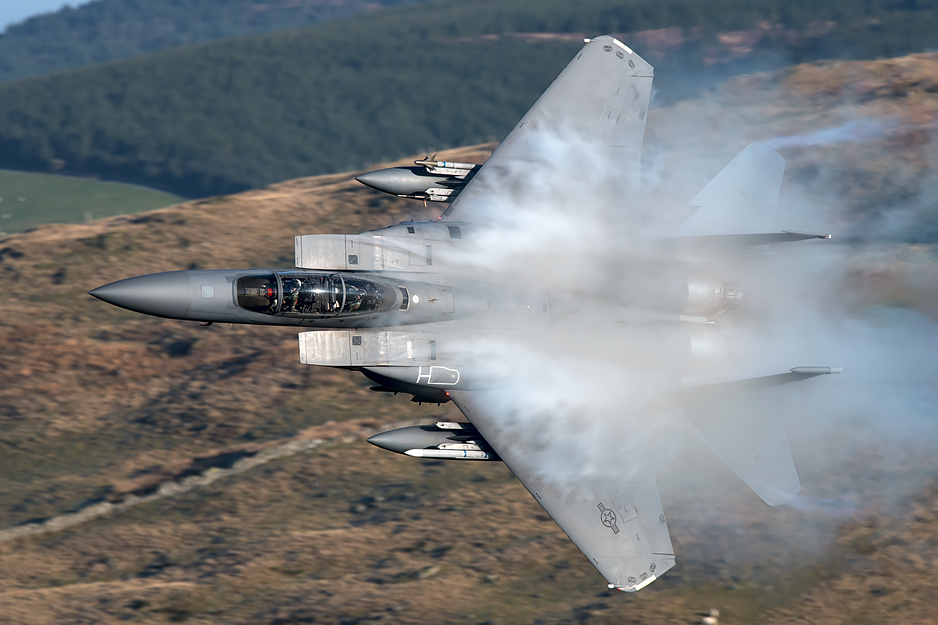 |
|
The F-15E is powered by two Pratt
& Whitney F100-PW-220 or 229 engines that incorporate
advanced digital technology for improved performance.
For example, with a digital electronic engine control
system, F-15E pilots can accelerate from idle power to
maximum afterburner in less than four seconds, a 40
percent improvement over the previous engine control
system. Faster engine acceleration means quicker
takeoffs and crisper response while manoeuvring. The
F100-PW-220 engines can produce 50,000 pounds of thrust
(25,000 each) and the F100-PW-229 engines 58,000 pounds
of thrust (29,000 each). |
|
|
|

Want to get in touch? Click on the icon above for email or you
can call me on 07817 905537

High Def Videos
Click
the link for a list of HD videos from the Mach loop and other locations.
|
 |